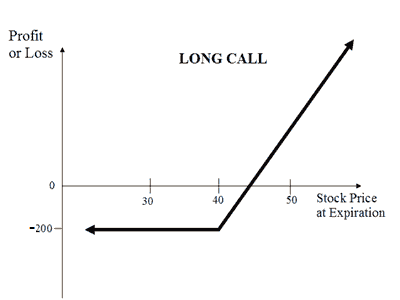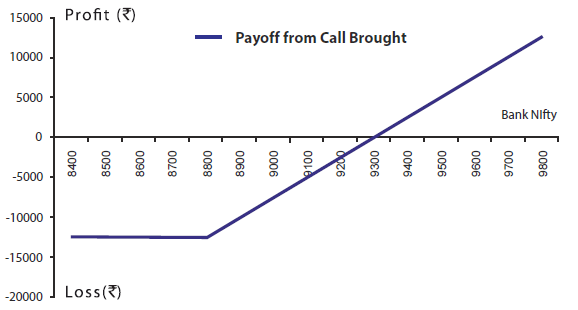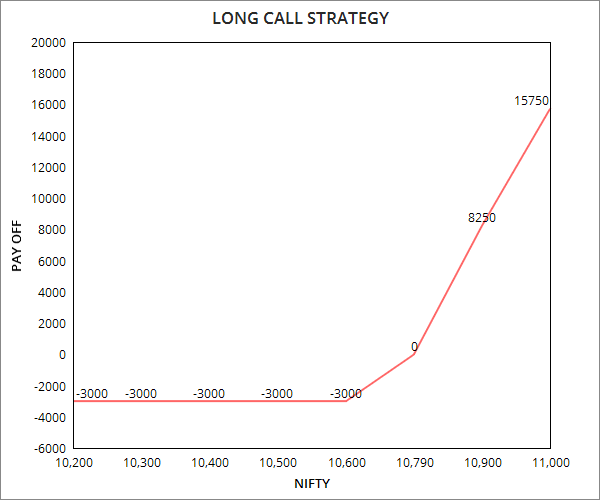 Zerodha (Trading & Demat Account)
Zerodha (Trading & Demat Account)
FREE Equity Delivery and MF
Flat ₹20/trade Intra-day/F&O
 Zerodha (Trading & Demat Account)
Zerodha (Trading & Demat Account)
FREE Equity Delivery and MF
Flat ₹20/trade Intra-day/F&O

|
|
Published on Tuesday, April 17, 2018 | Modified on Wednesday, June 5, 2019

| Strategy Level | Beginners |
| Instruments Traded | Call |
| Number of Positions | 1 |
| Market View | Bullish |
| Risk Profile | Limited |
| Reward Profile | Unlimited |
| Breakeven Point | Strike Price + Premium |
A Long Call Option trading strategy is one of the basic strategies. In this strategy, a trader is Bullish in his market view and expects the market to rise in near future. The strategy involves taking a single position of buying a Call Option (either ITM, ATM or OTM). This strategy has limited risk (max loss is premium paid) and unlimited profit potential.
When the trader goes long on call, the trader buys a Call Option and later sells it to earn profits if the price of the underlying asset goes up.
When the trader buys a call, he pays the option premium in exchange for the right (but not the obligation) to buy share or index at a fixed price by a certain expiry date. This premium is the only amount at-the-risk for trader in case the market moves in other direction (price of underlying asset falls).
In this strategy, we first buy a call and then close out the position later. This strategy should not be confused with 'Naked Call' where we sell calls and then buy them back at a cheaper price.
A long call Option strategy works well when you expect the underlying instrument to move positively in the recent future.
If you expect XYZ company to do well in near future then you can buy Call Options of the company. You will earn the profit if the price of the company shares closes above the Strike Price on the expiry date. However, if underlying shares don't do well and move downwards on expiry date you will incur losses (i.e. lose premium paid).
| Bank Nifty | Spot Price Rs | 8900 |
| Lot Size: 1 contract = 25 | Strike Price Rs | 8800 |
| Premium Rs | 500 | |
| Breakeven Rs (Strike Price + Premium) | 9300 |
| Bank Nifty on expiry Rs | Premium Pay-off Rs (Premium * Lot Size) | Exercise Pay-off Rs (Expiry Price - Strike Price) * Lot Size | Net Pay-off Rs (Exercise + Premium Payoff) |
|---|---|---|---|
| 8800 | -12500 | 0 | -12500 |
| 9000 | -12500 | 5000 | -7500 |
| 9200 | -12500 | 10000 | - 2500 |
| 9400 | -12500 | 15000 | 2500 |
| 9600 | -12500 | 20000 | 7500 |

Suppose you are bullish on Nifty today when the Nifty is trading at 10, 550. You can implement a long call strategy by buying a call option with a strike price of 10,750 at a premium of Rs 40. If the Nifty goes above 10,790, you will make a net profit on exercising the option. In case the Nifty stays at or falls below 10,750, you will make a maximum loss of the premium paid.
| Current Nifty | Rs 10,550 |
| Strike Price of Call Option | Rs 10,750 |
| Premium Paid | 40 X 75= Rs 3000 |
| Break Even Point (Strike Price + Premium) | Rs 10,790 |
| Lot Size | 75 |
| Nifty on Expiry (Rs ) | Net Payoff (Rs ) (Strike Price - Break Even Point) * Lot Size |
|---|---|
| 10,200 | -3000.00 |
| 10,300 | -3000.00 |
| 10,400 | -3000.00 |
| 10,500 | -3000.00 |
| 10,600 | -3000.00 |
| 10,790 | 0.00 |
| 10,800 | 750.00 |
| 10,900 | 8,250.00 |
| 11,000 | 15,750.00 |
Note: Break Even Point is 10,790. The maximum loss cannot be greater than Rs 40 premium paid.

When you're expecting a rise in the price of the underlying and increase in volatility.
A long call strategy involves buying a call option only. So if you expect Reliance to do well in near future then you can buy Call Options of Reliance. You will earn a profit if the price of Reliance shares closes above the Strike price on the expiry date. However, if Reliance shares don't move up within the expiry date you will incur losses.
Strike Price + Premium
The break-even point for Long Call strategy is the sum of the strike price and premium paid. Traders earn profits if the price of the underlying asset moves above the break-even point. Traders loose premium if the price of the underlying asset falls below the break-even point.
The risk is limited to the premium paid for the call option irrespective of the price of the underlying on the expiration date.
Max Loss = Premium Paid
There is no limit to maximum profit attainable in the long call option strategy. The trade gets profitable when price of the underlying is greater than strike price plus premium.
Profit = Price of Underlying - (Strike Price + Premium Paid)
Underlying closes above the strike price on expiry.
Underlying closes below the strike price on expiry.
Buying a Call Option instead of the underlying allows you to gain more profits by investing less and limiting your losses to minimum.
Call options have a limited lifespan. So, in case the price of your underlying stock is not higher than the strike price before the expiry date, the call option will expire worthlessly and you will lose the premium paid.


FREE Intraday Trading (Eq, F&O)
Flat ₹20 Per Trade in F&O
|
|
It should be Net pay off = Strike price + Premium price